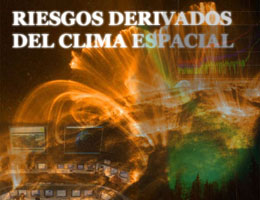Principal → Artículos Técnicos → Riesgos derivados del Clima Espacial → Referencias |
5. Referencias
-
“Severe Space Weather Events. Understanding Societal and Economic Impacts. A workshop report”. Space Studies Board. Division on Engineering and Physical Sciences. National Research Council of the National Academies, EE.UU., 2008.
-
Presentación del Dr. Arthur Charo (Senior Program Officer, Space Studies Board, National Research Council) en el “2010 Space Weather Enterprise Forum”. Washington, 8 de junio de 2010.
-
“National Space Weather Program advances on several fronts”. Gunzelman, M. y M.Babcock (2008). Space Weather Quarterly, volume 5, issue 4. American Geophysical Union.
-
“Grid Reliability and Infrastructure Defense Act”. Report 111-493. House of Representatives, 11th Congress, 2d Session. 25 de mayo de 2010. Disponible en: http://frwebgate.access.gpo.gov/cgi-bin/getdoc.cgi?dbname=111_cong_reports&docid=f:hr493.111.pdf
-
“El Sol, algo más que una estrella”. Manuel Vázquez Abeledo. 1ª.Ed. Sirius, 2004.
-
“Solar and Heliospheric Origins of Space Weather Phenomena”. Jean-Pierre Rozelot. Springer, 2006.
-
SIDC-team, World Data Center for the Sunspot Index, Royal Observatory of Belgium, Monthly Report on the International Sunspot Number, online catalogue of the sunspot index: http://www.sidc.be/sunspot-data/, ‘1755-2008’
-
“Forecasting Solar Cycle 24 using the relationship between cycle length and maximum sunspot number”. Watari, S. (2009). Space Weather Quarterly, volume 6, issue 1. American Geophysical Union.
-
Presentación de Vickie Nadolski (Deputy Assistant Administrator for Weather Services and Deputy Director, National Weather Service, NOAA) en el “2010 Space Weather Enterprise Forum”. Washington, 8 de junio de 2010.
-
Presentación del Col. Mark Zettlemoyer (Director of Weather, Headquarters, United States Air Force) en el “2010 Space Weather Enterprise Forum”. Washington, 8 de junio de 2010.
-
“Space Weather & Telecommunications”. John M. Goodman. Springer, 2005.
-
“Severe Space Weather. Social and Economic Impacts”. James A. Phillips. NASA Science News, 21/01/2009. Disponible en Internet: http://science.nasa.gov/science-news/science-at-nasa/2009/21jan_severespaceweather/
-
“Preparing for the upcoming solar maximum”. Tretkoff, E. (2009). Space Weather Quarterly, volume 6, issue 3. American Geophysical Union.
-
“Space Weather. The physics behind a slogan”. K.Scherer, H.Fichtner, B.Heber y U.Mall. Springer, 2005.
-
“Ionospheric scintillation effects on single frequency GPS”. R.A.Steenburgh et Al. (2008). Space Weather Quarterly, volume 5, issue 2. American Geophysical Union.
-
Orden ITC/332/2010, de 12 de febrero, por la que se aprueba el cuadro nacional de atribución de frecuencias (CNAF). BOE núm 44, 19 de febrero de 2010.
-
Presentación de Christopher J. Scolese (Associate Administrator, National Aeronautics and Space Administration) en el “2010 Space Weather Enterprise Forum”. Washington, 8 de junio de 2010.
-
“Glossary of Solar-Terrestrial Terms”. Space Weather Prediction Center. NOAA.
-
“Geomagnetically induced currents during intense storms driven by coronal mass ejections and corotating interacting regions”. Kataoka, R. y A. Pulkkinen (2008). J. Geophys. Res., 113
-
“Solar wind drivers of large scale geomagnetically induced currents during the solar cycle 23”. Huttunen, K. et Al. Space Weather Quarterly, volume 6, issue 1. American Geophysical Union.
-
“Improved modeling of geomagnetically induced currents in the South African power network”. Chigomezyo, M. et Al. (2009). Space Weather Quarterly, volume 6, issue 2. American Geophysical Union.
-
“The Great Storm: Solar Tempest of 1859 Revealed”. Robert R. Britt. Octubre 2003. http://www.space.com/scienceastronomy/mystery_monday_031027.html
-
Presentación del Cap. Paul Stewart (Commanding Officer, Naval Research Laboratory, United States Navy) en el “2010 Space Weather Enterprise Forum”. Washington, 8 de junio de 2010.
-
“Meteorología Espacial”. Sanahuja, B. (Departamento de Astronomía y Meteorología, Facultad de Física, Universidad de Barcelona). Revista Española de Física, vol.17, nº4 (2003).
-
“The Bastille Day Event”. Geophysical Institute. University of Alaska Fairbanks. http://gse.gi.alaska.edu/bastilleday.html
-
“Space weather in the FY 2009 U.S. federal budget request”. Kumar, M. (2008). Space Weather Quarterly, volume 5, issue 1. American Geophysical Union.
-
“Proposed U.S. Space Weather Budget”. Showstack, R. (2009). Space Weather Quarterly, volume 6, issue 3. American Geophysical Union.
-
“Renewed support dawns in Europe: An action to develop space weather products and services”. Belehaki, A et Al. (2009). Space Weather Quarterly, volume 6, issue 1. American Geophysical Union.
-
Presentación de Juha-Pekka Luntama (Space Situational Awareness Programme, Space Weather Manager, European Space Agency, European Space Astronomy Centre, Madrid, Spain) en el “2010 Space Weather Enterprise Forum”. Washington, 8 de junio de 2010.
-
“Space weather studies in Australia”. Wilkinson, P. (2009). Space Weather Quarterly, volume 6, issue 2. American Geophysical Union.
-
“Under the lens: Investigating the Sun’s mysteries”. Harwood, W. e I.Klotz (2008). Space Weather Quarterly, volume 5, issue 4. American Geophysical Union.
-
“Lessons from aviation: Linking space weather science to decision making”. Fisher, G. (2009). Space Weather Quarterly, volume 6, issue 1. American Geophysical Union
NOTA: puede realizar el seguimiento en tiempo real de la actividad solar a través del Panel de Radio HF y Clima Espacial, disponible en esta misma web.
Ismael Pellejero - EA4FSI |




